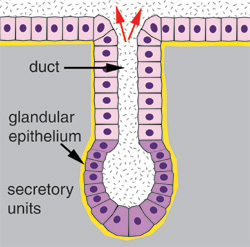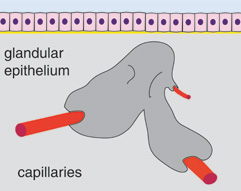Epithelia: Functions of the Two Major Types of Epithelia
What are epithelia?
Epithelia are continuous sheets of cells (one or more layers thick) that cover the exterior
surfaces of the body, line internal closed cavities and body tubes
that communicate with the outside environment (the alimentary,
respiratory and genitourinary tracts), make up the secretory portions
of glands and their ducts, and are found in the sensory receptive
regons of certain sensory organs (e.g. ear & nose).
What do they do?
Epithelia cover and lining surfaces (e.g. skin), are involved in absorption (e.g. the intestine), secretion (e.g. glands), can be sensory (e.g. neuroepithelium) or contractile (e.g. myoepithelial cells).
What are their characteristics?
Epithelia are a continuous sheet of cells covering the surfaces
of the body. They stand on a basement
membrane which provides a site of attachment for the epithelium,
and acts as a selective filtration barrier. There is very little
intercellular material. Epithelia do not have their own blood
supply (avascular), they rely on diffusion for
exchange of oxygen and metabolites. Epithelia contain specialised cell-cell junctions
that bind adjacent cells to each other. They also contain communicating junctions (gap junctions) that allow allow communication
between adjacent cells. Click here to find out about cell-cell
junctions. Cells in epithelia show a polarity along the axis between the external and internal environment,
and their apical (free) surfaces often exhibit modifications.
There are two major types of epithelia:
Covering epithelia and Glandular epithelia
(Note: epithelia is the plural form of epithelium!)
Covering Epithelia are important for:
Selective diffusion - for example transfer of gases, nutrients
and waste products between the blood and surrounding tissues.
These epithelia are usually simple squamous type, to provide the
smallest barrier to diffusion. Click here to see some simple squamous epithelia.
Absorption/secretion - for example absorption of nutrients
from the gut, and secretion of enzymes for digestion. These epithelia
are usually columnar, as the cells contain lots of endoplasmic
reticulum, and golgi, for secretion, and they often have microvilli,
to increase the surface area of the apical surface for absorption.
Click here to see some examples of
columnar epithelia.
Physical protection - for example, the skin protects underlying
tissues from sunlight, heat, cold, abrasion, etc. These epithelia
are always stratified (many layers), and can sometimes be keratinised
on its apical surface, as in skin. The keratin helps to waterproof
the skin. Click here to find
out about stratified epithelia.
Containment - i.e. a barrier between the inside and outside
of the gut etc.
Glandular Epithelia:
Glands are an organised collection of secretory epithelial
cells. Most glands are formed during development by proliferation
of epithelial cells so that they project into the underlying connective
tissue. Some glands retain their continuity with the surface via
a duct and are known as EXOCRINE GLANDS. Other glands lose this
direct continuity with the surface when their ducts degenerate
during development. These glands are known as ENDOCRINE glands.
Thus the two types of glands are called : Exocrine and Endocrine.

Exocrine Glands
Can be Unicellular - Goblet cells, or Multicellular
All exocrine glands are glands with ducts. The secretions are delivered into ducts and end up on the epithelial surface. For example, the sweat glands are exocrine glands.
There are several different basic types of exocrine glands. Click here to find out what types of exocrine glands there are.

Endocrine Glands
Glands without ducts. The secretions are released directly into the blood stream.
Glands are dealt with in more detail in the Glandular Tissues topic.
Now test your knowledge out with this crossword puzzle.

